Jump to: Origins of Fool's Gold | Chalcopyrite | Weathered Mica | Pyrite | Fool's Gold vs Real Gold | Unique Characteristics | Gold as an Investment
Imagine striking it rich, uncovering a gleaming, golden rock in the dirt, and celebrating your newfound fortune—only to discover that your treasure is worthless.
This heartbreaking scenario has played out countless times throughout history, thanks to a deceptive mineral known as Fool’s Gold.
But what exactly is Fool’s Gold, and why has it tricked so many hopeful prospectors? In this article, we’ll explore its origins, how to identify it, and why real gold remains a wise investment choice.
The Origins of Fool’s Gold
In short, fool’s gold can refer to three minerals: Pyrite, Chalcopyrite, and weathered Mica. Among them, Pyrite is the most commonly mistaken for gold.
Pyrite has been known to humans for centuries, but it wasn’t until the great gold rushes of the 19th century that it gained its infamous reputation. Eager prospectors, hoping to strike it rich, often mistook pyrite for actual gold, only to be bitterly disappointed when they realized its true nature.
Interestingly, pyrite wasn’t always a symbol of deception. In ancient civilizations, including those of the Greeks and Romans, pyrite was valued for its ability to create sparks when struck against metal, making it an essential tool for fire-starting. Additionally, some cultures believed pyrite held mystical properties and used it for decorative and ceremonial purposes.
But in the era of the Gold Rush, its resemblance to gold earned it the name "Fool’s Gold," serving as a cautionary reminder that not everything that glitters is valuable.
Chalcopyrite
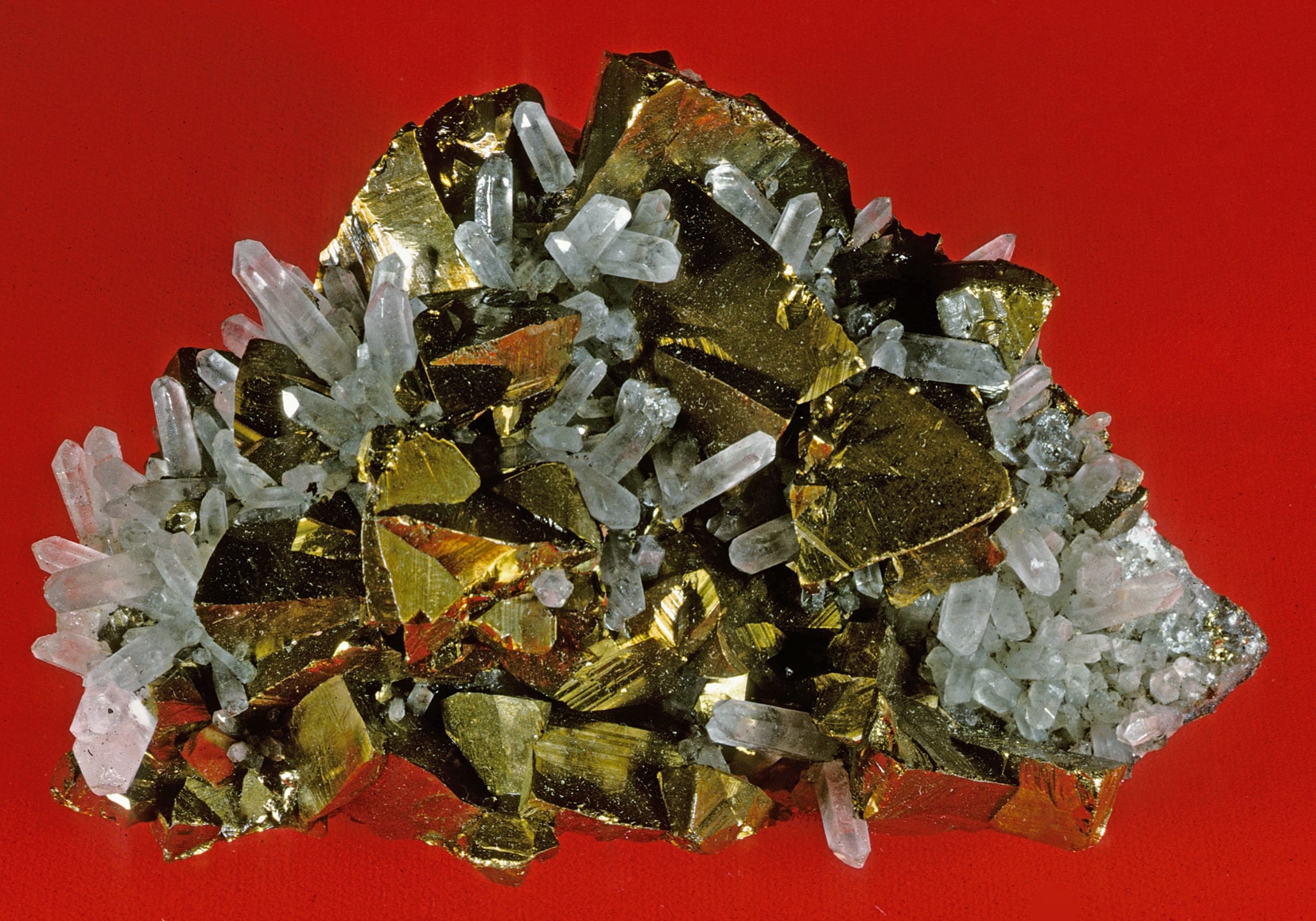
Image credit: Chalcopyrite on Quartz, British Museum of Natural History. Copyright © Rock Currier. Retrieved from Mindat.
Chalcopyrite is the most common mineral containing copper, from which the metal can be extracted. It typically forms in ore veins deposited at medium to high temperatures.
While gold is ductile, malleable, and nearly indestructible, chalcopyrite is brittle and will shatter if struck.
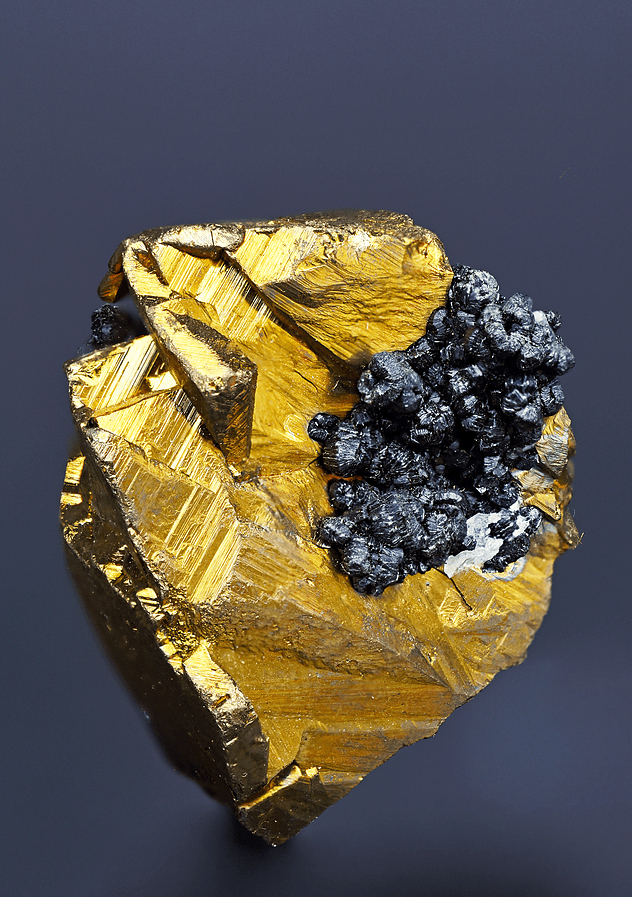
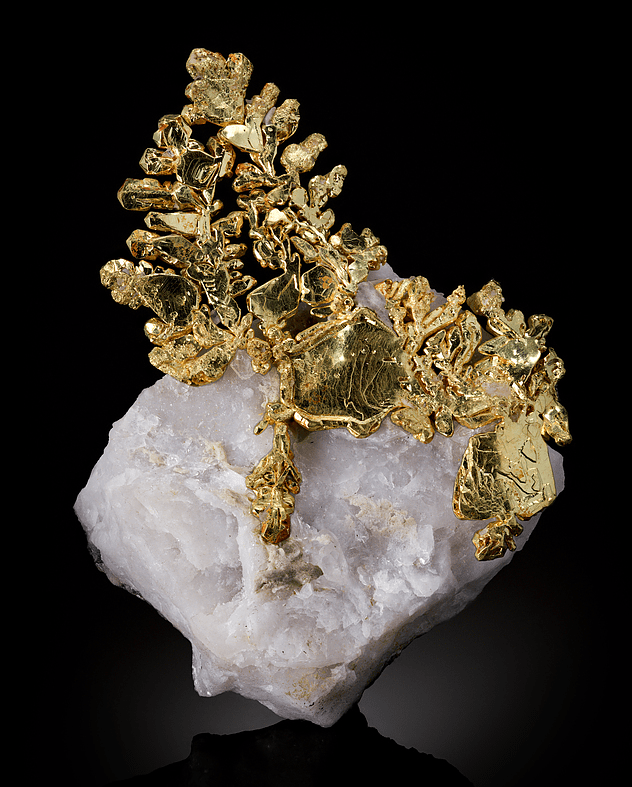
Chalcopyrite vs Gold
Chalcopyrite Image: Black clusters of chamosite on chalcopyrite crystal. Source: Mindat.
Gold Image: Gold on Quartz. Source: Mindat, © Matt McGill.
Weathered Mica
Weathered mica can appear golden yellow and bronzy, which can lead to its being mistaken for gold.

Image credit: Fukuto at English Wikipedia – Licensed under CC BY-SA 3.0 and the GNU Free Documentation License.
While gold is a metal consisting of pure elemental atoms, mica is a silicate mineral composed of silica, aluminum, potassium, iron, and magnesium, arranged in thin, sheet-like layers.
The atomic arrangement within these layers allows mica to be easily split into delicate, transparent sheets, making it highly versatile for various applications, but also making it easier to tell it from real gold which often occurs in nuggets in a generally granular texture.
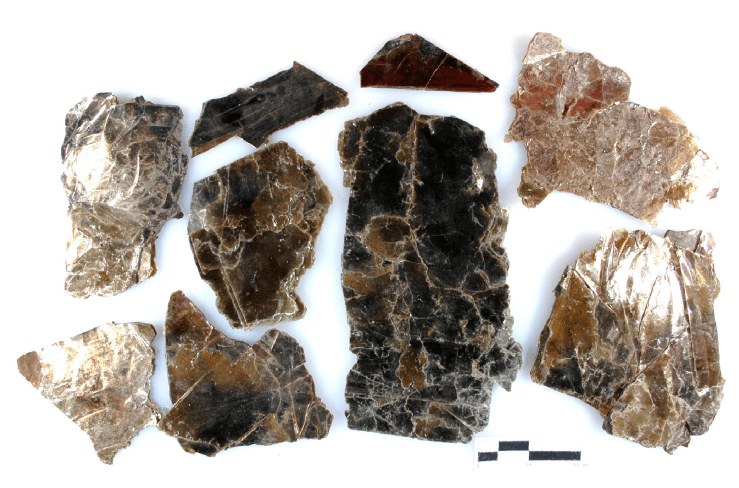
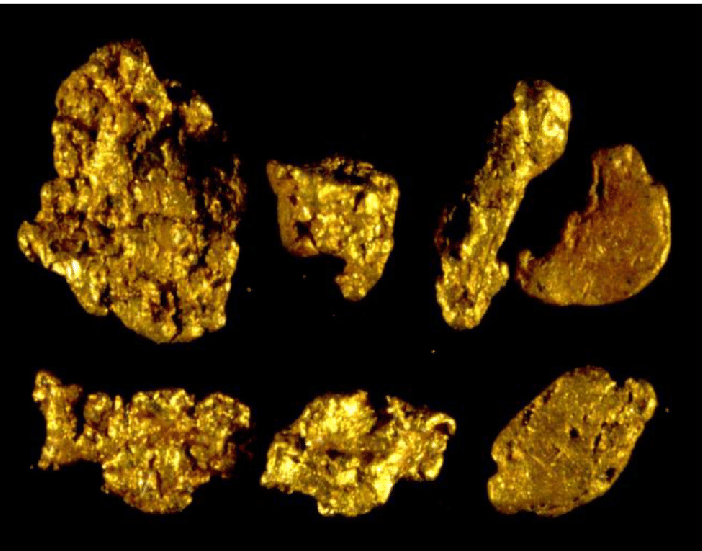
Mica VS. Gold
Mica Image: Micas Teotihuacanas. Source: ZAT-INAH, photo by Miguel Morales.
Gold Image: Morphology of gold grains. Source: Honore Tcharo.
Pyrite
Pyrite, the most common mineral mistaken for gold, is an iron sulfide. Its name comes from the Greek word pyr, meaning "fire," because it emits sparks when struck against metal.
Its resemblance to gold stems from its bright, yellowish color, which can mimic the appearance of a gold nugget to the inexperienced eye.
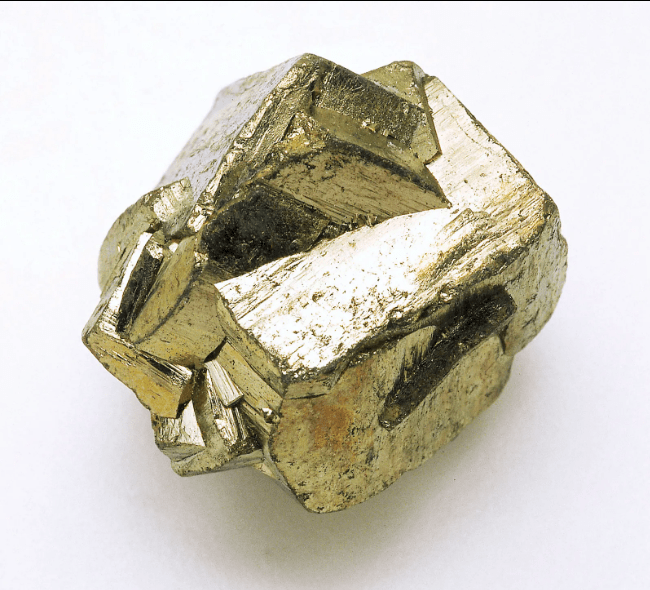
Image source: Encyclopædia Britannica, Pyrite, accessed March 28, 2025.
Due to their similar geological conditions, gold fragments are sometimes found within pyrite formations.
Pyrite commonly occurs as an accessory mineral in igneous rocks and is often found in vein deposits alongside quartz and sulfide minerals.
However, the similarities between pyrite and our precious yellow metal stop there.
Fool’s Gold vs Real Gold
If you were panning for gold, how could you avoid falling for Fool’s Gold? Fortunately, there are a few key differences between pyrite and real gold that make it easy to tell them apart:
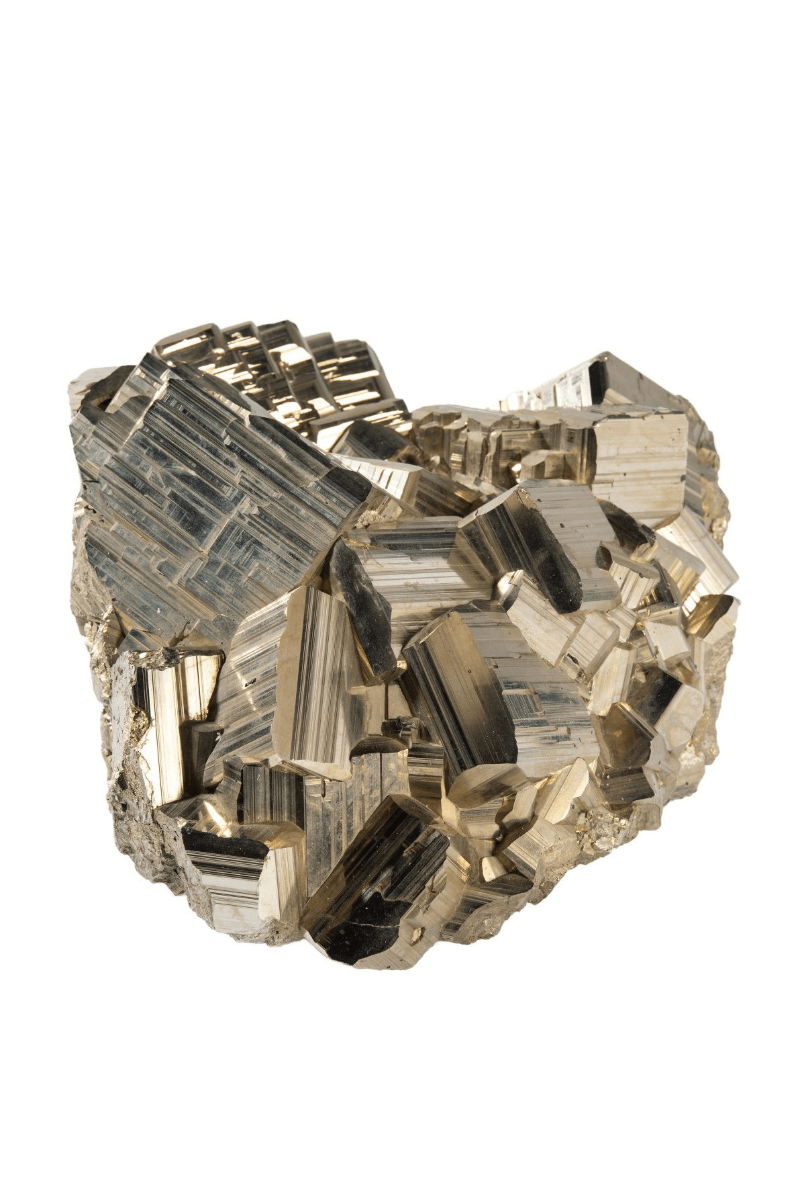
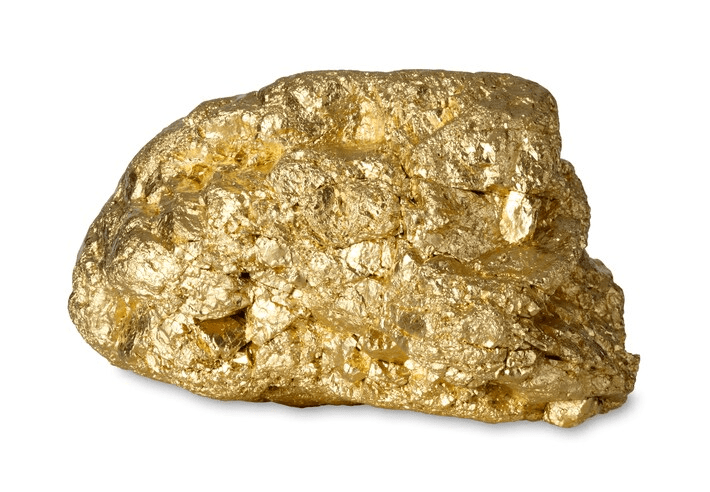
Pyrite VS. Gold
Pyrite Image: Source: Australian Museum.
Gold Image: Source: Thermo Fisher Scientific.
- Color and form: a key visual difference between pyrite and gold is Pyrite’s pale color and high luster, a result of its crystalline structure. In contrast, gold has a more uniform shine that remains bright.
- Density: pyrite also differs from gold in density. With a specific gravity of 4.9–5.2, pyrite is much lighter than gold, which has a density of 19.3. To test this, compare their weights, gold will feel noticeably heavier than pyrite of the same size.
- Magnetic properties: pyrite can exhibit magnetic properties due to the presence of iron or other elements within it, while pure gold is never magnetic.
- Shape: another distinguishing feature is that pyrite often forms in cubic shapes, owing to its atomic structure, whereas gold typically occurs in nuggets or grains.
- Tarnishing: over time, pyrite can tarnish, turning brown or even black, even maintaining the similarity with gold. While the last one, remains untarnished and retains its shine.
- Formation: Interestingly, pyrite can indicate that gold is nearby, as they often form under similar geological conditions. In fact, during mining, real gold can sometimes be found embedded within pyrite deposits.
- Origin: It's important to note that pyrite is naturally formed in nature, while gold isn't naturally formed on Earth; it originates from cosmic events that release immense energy, creating heavy metals like gold, which gravity later pulled into the planet’s core and is brought to surface through geological phenomenons.
Click here to learn more about how gold is formed.
Although pyrite is often mistaken for gold, it has substantial value. Ancient civilizations used it to start fires, and today, it remains essential in the chemical, pharmaceutical, and defense industries.
Pyrite is also a major source of sulfur, a key component in sulfuric acid, one of the most widely produced industrial chemicals. So, while it may be called "fool’s gold," it’s far from foolish!
For those looking to safeguard their wealth, purchasing gold bullion from reputable dealers is a smart move. Unlike Fool’s Gold, which only mimics wealth, real gold offers true value and long-term financial stability.
Unique Characteristics of Real Gold
Gold is valued not only for its beauty and historical significance but also for its unique properties and rarity. It is highly resistant to chemical reactions, does not easily combine with other elements, and is considered a noble metal due to its stable structure, making it nearly indestructible.
What truly sets gold apart from all the fool’s gold mentioned earlier is its resistance, as gold will never shatter. Unlike these minerals, which flake, powder, or crumble when poked with a metal point, gold is malleable, gouging or indenting like soft lead.
If you can break it with a hammer, it's not gold.
The yellow metal is incredibly malleable and easily shaped into jewelry, gold bars, and coins.
Gold as an Investment
While Fool’s Gold may have led to many disappointments in the past, real gold remains a cornerstone of wealth preservation and investment.
Unlike pyrite, which has little commercial value, gold is highly sought after for its rarity, beauty, and utility in jewelry, electronics, and global finance.
Investing in gold bullion — whether in the form of gold coins or bars — provides financial security, acting as a hedge against inflation and economic uncertainty. Unlike paper currency, which can lose value over time, gold has maintained its worth for thousands of years, making it a preferred choice for investors worldwide.
For those looking to safeguard their wealth, purchasing gold bullion from reputable dealers is a smart move. Unlike Fool’s Gold, which only mimics wealth, real gold offers true value and long-term financial stability.
The Real Deal
Knowing how to distinguish real gold from its lookalikes is crucial for collectors, investors, and enthusiasts alike. By understanding key differences, such as weight, malleability, and chemical properties, you can avoid being fooled by minerals like pyrite, chalcopyrite, and mica.
And if you’re thinking about investing in gold, remember: its value goes beyond appearances; it’s a timeless asset that has preserved wealth for centuries.


















